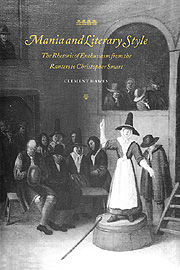Book contents
- Frontmatter
- Contents
- Acknowledgments
- Introduction: Mania as rhetoric
- PART I DEFIANT VOICE
- PART II PATRICIAN DIAGNOSIS
- 4 Return to madness: mania as plebeian vapors in Swift
- PART III CHALLENGING LIMINALITY
- Epilogue: Beyond pathology
- Index
- CAMBRIDGE STUDIES IN EIGHTEENTH-CENTURY ENGLISH LITERATURE AND THOUGHT
4 - Return to madness: mania as plebeian vapors in Swift
Published online by Cambridge University Press: 16 September 2009
- Frontmatter
- Contents
- Acknowledgments
- Introduction: Mania as rhetoric
- PART I DEFIANT VOICE
- PART II PATRICIAN DIAGNOSIS
- 4 Return to madness: mania as plebeian vapors in Swift
- PART III CHALLENGING LIMINALITY
- Epilogue: Beyond pathology
- Index
- CAMBRIDGE STUDIES IN EIGHTEENTH-CENTURY ENGLISH LITERATURE AND THOUGHT
Summary
But to return to Madness.
Jonathan Swift, A Tale of a TubIt is typical of the narrator of A Tale of a Tub that through a telling ambiguity he unwittingly collapses language about madness into language of madness. Thus he ends a digression with the richly ironic phrase, “But to return to Madness.” This irony at the tale-teller's expense signals that Jonathan Swift is not “of” the manic in the same sense that Abiezer Coppe and Christopher Smart are. Nevertheless, in A Tale of a Tub Swift deliberately parodies, and thus reproduces, the mode I have termed a rhetoric of mania. Swift puts on a style that includes such manic features as a stance of inspired omnipotence, levelling catalogues, irreverent punning, and non-linear reading techniques. A Tale of a Tub, moreover – through its “stammering” quality of self-interruption and its tendency toward fusion with the reader addressed or thing described – parodies the unorthodox rhetoric of enunciation common among enthusiastic writers. The Tale, finally, not only echoes such enthusiastic commonplaces as the “pranks” and “incarceration” topoi; it in fact elaborates its entire religious allegory, dealing with the politics of inheriting a scriptural tradition, as a revision of the sectarian “two sons” topos.
Swift's satire mocks both radical Protestant enthusiasm and certain dynamics of literary production that he represents as novel in the 1690s.
- Type
- Chapter
- Information
- Mania and Literary StyleThe Rhetoric of Enthusiasm from the Ranters to Christopher Smart, pp. 101 - 126Publisher: Cambridge University PressPrint publication year: 1996



